-
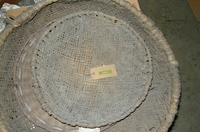 Yucca Basket
Yucca Basket This yucca sifter basket was collected from the Hopi tribe of Arizona. Sifter baskets are used by the Hopi to sift debris from food and for storage.
-
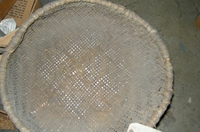 Yucca Basket
Yucca Basket This yucca sifter basket was collected from the Hopi tribe of Arizona. It was tagged by the U.S. National Museum, the forerunner to the Smithsonian museums.
-
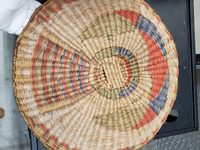 Meal tray
Meal tray This colorful basket was collected from the Hopi tribe of Arizona by Mooney, an anthropologist who worked extensively with Indigenous cultures. The basket depicts a kachina, or spiritual figure.
-
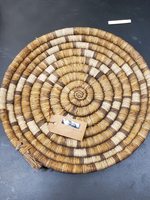 Meal Tray
Meal Tray This artifact is a meal tray from the Hopi Tribe of Arizona. This piece in our records is contaminated by the compound of Mercury Chloride. Poisons and toxic chemicals, like Mercury Chloride and Arsenic, were often used in Museum collections as a means to help preserve this artifact. This creates complications however in their maintenance and handling. Mercury Chloride specifically was used to help preserve organic objects by protecting them against insects. Our collection contains a few objects contaminated by toxic chemical compounds.
-
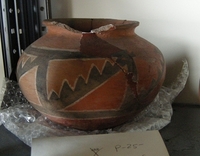 Jar
Jar This Hopi jar has severe damage, missing pieces that have broken off from the main body. Despite this, the jar has a vibrant painted design, with a bright red base and black geometric steps outlined in white. The design is simple, unlike the more intricate ones found on other jars in the collection.
-
 Jar
Jar This jar is labeled Moki, a word that used to be used to describe the Hopi tribe of Arizona. However, current scholarship in pitched basketry jars such as this one suggests that it was more likely made by the Southern Paiute, who traded it to the Hopi, who used it for transporting water. It was collected at Hopi by John Wesley Powell, who sent it to the Smithsonian in 1883 via Mindeleff, an architect who was working in the Southwest at the time.
-
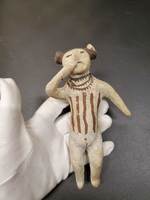 Doll figurine
Doll figurine This ceramic Hopi doll figurine was collected by J.W. Fewkes in Arizona. She is painted using a white as a base coat and brown and auburn for details. We know she is female by the clear and deliberate slit running from front to back in between her legs. She has several small blushes and was likely used as a toy for young children.
-
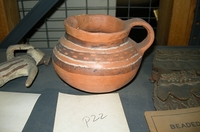 Cup
Cup This cup was collected at an archaeological site in Homolobi, Arizona, by Fewkes, an early archaeologist. The redware pottery, decorated with simple bands of black and white, is slightly more decorated than the other cup from Homolobi in the Lafayette Collection.
-
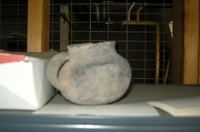 Cup
Cup This cup was collected at an archaeological site in Homolobi, Arizona, by Fewkes, an early archaeologist. Its black coloring is utilitarian, showing that it was a simple piece used for cooking, rather than an elaborate display piece.
-
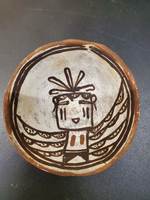 Ceremonial bowl: Kachina, Spirit Dancer
Ceremonial bowl: Kachina, Spirit Dancer Collected by Matilda Coxe Stevenson, this Hopi bowl was acquired in Arizona. This coil bowl has a painting of a Hopi spirit, similar to the mask designs of the Kachinas, filling its interior. There are notable characteristics, such as the paired vertical lines on the beings face, the head feathers and the wings which are generally associated with identifiable spirits. The underside of the bowl has two significant features as well: the original red identification numbers, 226, and a sizable blushing.
-
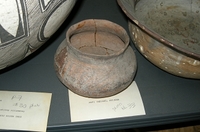 Bowl:water symbols
Bowl:water symbols This jar has been damaged and pieced back together, a common occurrence with archaeological objects that are crushed underground. The piece would have been considered more valuable to collectors in its completed form.
-
 Bowl:broken bands motif
Bowl:broken bands motif This bowl was collected from an archaeological site near Chevlon, Arizona, by J. W. Fewkes, an early archaeologist who worked on numerous sites throughout the Southwest.
-
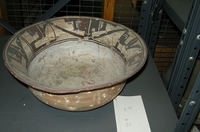 Bowl:bird symbols
Bowl:bird symbols This bowl has pockmarks caused by salt eroding the ceramic. This probably shows that the bowl was used, perhaps to serve a salty stew, before it was collected.
-
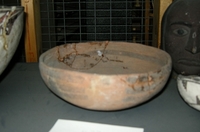 Bowl
Bowl This bowl was collected from an archaeological site at Chevlon, Arizona. The bowl was broken into several pieces, probably at some point in the process of burial and subsequent uncovering. Archaeologists valued complete objects, which explains the detailed work undertaken to repair this bowl.
-
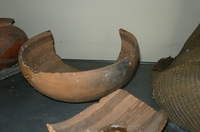 Bowl
Bowl This broken bowl is not marked with a collector or location, unlike other bowls in our collection. It is possible that it was collected by Fewkes, who conducted archaeological studies in the Southwest and contributed most of the older ceramics in the Lafayette Indigenous collection.
-
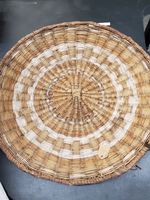 Basket Tray
Basket Tray This work is a wicker plaque, or flat woven tray, created by a member of the Hopi tribe. Someone, either the collector or a later museum employee, attached a tag to the basket to note that it was collected from the Hopi village of Oraibi and that it was made with natural dyes. These dyes were more desirable to collectors attempting to find “authentic” examples of Hopi craft than commercially sold dyes.
-
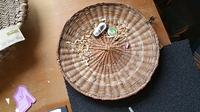 Basket Tray
Basket Tray This is a wicker plaque, or flat woven tray, created by a member of the Hopi tribe. It could have been used to serve food such as piki, a thin and crispy food made with blue cornmeal.
-
Hat
This hat is from the Haida Tribe of Alaska. The animal depicted on this hat is a raven, done in the formline style of the Northwestern Coasts of the Americas. Painted woven hats with formline art, such as this piece, were a common item made and sold by Haida women to tourists in the late nineteenth Century.
-
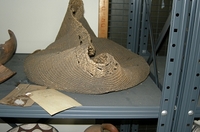 Basket
Basket This basket was collected by E. W. Nelson in Norton Sound, Alaska, when he was stationed there with the U.S. Army Signal Corps to study local flora and fauna from 1887 to 1881. The basket was likely made by a Yup’ik maker and used for carrying clothing.
-
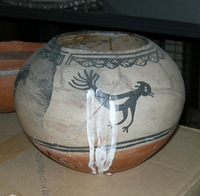 Bowl: star symbols with birds
Bowl: star symbols with birds This jar is the only example in our collection of a work from Cochiti, a Pueblo near Santa Fe. Unfortunately, the work has been contaminated with arsenic, a poison used as a pest preventative in early museum collections. The decorative motifs on the jar are typical of Cochiti designs.
-
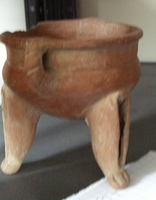 Tripodal cup
Tripodal cup This cup was acquired in Panama, , 8° 42’ N, 82° 50’ W. Itfeatures rattle legs with moveable balls inside. The balls make noise when the cup is used, and may serve a funerary purpose. This example is stouter than the other rattle leg cup in our collection, showing a variety in designs for the form.
-
 Tripodal cup
Tripodal cup The tall Chiriqui style tripodal cup was acquired in Panama. It was likely used as a vase, however, it is unclear whether it was a domestic or ceremonial item. If ceremonial, it was likely taken from burial grounds and brought to the Smithsonian as ethnographic artifacts.
-
 Tripodal bowl
Tripodal bowl This prehistoric short tripodal cup from Chiriqui does not have the rattle legs of the other Chiriqui cups in our collection. This sturdy cup could hold more liquid than the others, but would not be able to complete the same ceremonial function without the audible movement in the legs.
-
 Jar
Jar This jar is from Chiriqui, a region of Panama named for the last Indigenous archaeological period prior to colonization. It is a type of pottery known alternatively as Armadillo ware, or San Miguel Biscuit ware, or Tarrago Biscuit ware.
-
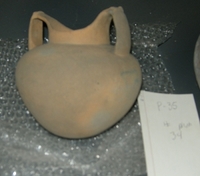 Jar
Jar This undecorated jar probably had a utilitarian function. It’s double handles and globular body would make it convenient for carrying liquid. Waities, who collected the Chiriqui objects in the Lafayette Collection, was probably interested in collecting a variety of ceremonial and utilitarian ceramics, to show the breadth of uses.
 Yucca Basket This yucca sifter basket was collected from the Hopi tribe of Arizona. Sifter baskets are used by the Hopi to sift debris from food and for storage.
Yucca Basket This yucca sifter basket was collected from the Hopi tribe of Arizona. Sifter baskets are used by the Hopi to sift debris from food and for storage. Yucca Basket This yucca sifter basket was collected from the Hopi tribe of Arizona. It was tagged by the U.S. National Museum, the forerunner to the Smithsonian museums.
Yucca Basket This yucca sifter basket was collected from the Hopi tribe of Arizona. It was tagged by the U.S. National Museum, the forerunner to the Smithsonian museums. Meal tray This colorful basket was collected from the Hopi tribe of Arizona by Mooney, an anthropologist who worked extensively with Indigenous cultures. The basket depicts a kachina, or spiritual figure.
Meal tray This colorful basket was collected from the Hopi tribe of Arizona by Mooney, an anthropologist who worked extensively with Indigenous cultures. The basket depicts a kachina, or spiritual figure. Meal Tray This artifact is a meal tray from the Hopi Tribe of Arizona. This piece in our records is contaminated by the compound of Mercury Chloride. Poisons and toxic chemicals, like Mercury Chloride and Arsenic, were often used in Museum collections as a means to help preserve this artifact. This creates complications however in their maintenance and handling. Mercury Chloride specifically was used to help preserve organic objects by protecting them against insects. Our collection contains a few objects contaminated by toxic chemical compounds.
Meal Tray This artifact is a meal tray from the Hopi Tribe of Arizona. This piece in our records is contaminated by the compound of Mercury Chloride. Poisons and toxic chemicals, like Mercury Chloride and Arsenic, were often used in Museum collections as a means to help preserve this artifact. This creates complications however in their maintenance and handling. Mercury Chloride specifically was used to help preserve organic objects by protecting them against insects. Our collection contains a few objects contaminated by toxic chemical compounds. Jar This Hopi jar has severe damage, missing pieces that have broken off from the main body. Despite this, the jar has a vibrant painted design, with a bright red base and black geometric steps outlined in white. The design is simple, unlike the more intricate ones found on other jars in the collection.
Jar This Hopi jar has severe damage, missing pieces that have broken off from the main body. Despite this, the jar has a vibrant painted design, with a bright red base and black geometric steps outlined in white. The design is simple, unlike the more intricate ones found on other jars in the collection. Jar This jar is labeled Moki, a word that used to be used to describe the Hopi tribe of Arizona. However, current scholarship in pitched basketry jars such as this one suggests that it was more likely made by the Southern Paiute, who traded it to the Hopi, who used it for transporting water. It was collected at Hopi by John Wesley Powell, who sent it to the Smithsonian in 1883 via Mindeleff, an architect who was working in the Southwest at the time.
Jar This jar is labeled Moki, a word that used to be used to describe the Hopi tribe of Arizona. However, current scholarship in pitched basketry jars such as this one suggests that it was more likely made by the Southern Paiute, who traded it to the Hopi, who used it for transporting water. It was collected at Hopi by John Wesley Powell, who sent it to the Smithsonian in 1883 via Mindeleff, an architect who was working in the Southwest at the time. Doll figurine This ceramic Hopi doll figurine was collected by J.W. Fewkes in Arizona. She is painted using a white as a base coat and brown and auburn for details. We know she is female by the clear and deliberate slit running from front to back in between her legs. She has several small blushes and was likely used as a toy for young children.
Doll figurine This ceramic Hopi doll figurine was collected by J.W. Fewkes in Arizona. She is painted using a white as a base coat and brown and auburn for details. We know she is female by the clear and deliberate slit running from front to back in between her legs. She has several small blushes and was likely used as a toy for young children. Cup This cup was collected at an archaeological site in Homolobi, Arizona, by Fewkes, an early archaeologist. The redware pottery, decorated with simple bands of black and white, is slightly more decorated than the other cup from Homolobi in the Lafayette Collection.
Cup This cup was collected at an archaeological site in Homolobi, Arizona, by Fewkes, an early archaeologist. The redware pottery, decorated with simple bands of black and white, is slightly more decorated than the other cup from Homolobi in the Lafayette Collection. Cup This cup was collected at an archaeological site in Homolobi, Arizona, by Fewkes, an early archaeologist. Its black coloring is utilitarian, showing that it was a simple piece used for cooking, rather than an elaborate display piece.
Cup This cup was collected at an archaeological site in Homolobi, Arizona, by Fewkes, an early archaeologist. Its black coloring is utilitarian, showing that it was a simple piece used for cooking, rather than an elaborate display piece. Ceremonial bowl: Kachina, Spirit Dancer Collected by Matilda Coxe Stevenson, this Hopi bowl was acquired in Arizona. This coil bowl has a painting of a Hopi spirit, similar to the mask designs of the Kachinas, filling its interior. There are notable characteristics, such as the paired vertical lines on the beings face, the head feathers and the wings which are generally associated with identifiable spirits. The underside of the bowl has two significant features as well: the original red identification numbers, 226, and a sizable blushing.
Ceremonial bowl: Kachina, Spirit Dancer Collected by Matilda Coxe Stevenson, this Hopi bowl was acquired in Arizona. This coil bowl has a painting of a Hopi spirit, similar to the mask designs of the Kachinas, filling its interior. There are notable characteristics, such as the paired vertical lines on the beings face, the head feathers and the wings which are generally associated with identifiable spirits. The underside of the bowl has two significant features as well: the original red identification numbers, 226, and a sizable blushing. Bowl:water symbols This jar has been damaged and pieced back together, a common occurrence with archaeological objects that are crushed underground. The piece would have been considered more valuable to collectors in its completed form.
Bowl:water symbols This jar has been damaged and pieced back together, a common occurrence with archaeological objects that are crushed underground. The piece would have been considered more valuable to collectors in its completed form. Bowl:broken bands motif This bowl was collected from an archaeological site near Chevlon, Arizona, by J. W. Fewkes, an early archaeologist who worked on numerous sites throughout the Southwest.
Bowl:broken bands motif This bowl was collected from an archaeological site near Chevlon, Arizona, by J. W. Fewkes, an early archaeologist who worked on numerous sites throughout the Southwest. Bowl:bird symbols This bowl has pockmarks caused by salt eroding the ceramic. This probably shows that the bowl was used, perhaps to serve a salty stew, before it was collected.
Bowl:bird symbols This bowl has pockmarks caused by salt eroding the ceramic. This probably shows that the bowl was used, perhaps to serve a salty stew, before it was collected. Bowl This bowl was collected from an archaeological site at Chevlon, Arizona. The bowl was broken into several pieces, probably at some point in the process of burial and subsequent uncovering. Archaeologists valued complete objects, which explains the detailed work undertaken to repair this bowl.
Bowl This bowl was collected from an archaeological site at Chevlon, Arizona. The bowl was broken into several pieces, probably at some point in the process of burial and subsequent uncovering. Archaeologists valued complete objects, which explains the detailed work undertaken to repair this bowl. Bowl This broken bowl is not marked with a collector or location, unlike other bowls in our collection. It is possible that it was collected by Fewkes, who conducted archaeological studies in the Southwest and contributed most of the older ceramics in the Lafayette Indigenous collection.
Bowl This broken bowl is not marked with a collector or location, unlike other bowls in our collection. It is possible that it was collected by Fewkes, who conducted archaeological studies in the Southwest and contributed most of the older ceramics in the Lafayette Indigenous collection. Basket Tray This work is a wicker plaque, or flat woven tray, created by a member of the Hopi tribe. Someone, either the collector or a later museum employee, attached a tag to the basket to note that it was collected from the Hopi village of Oraibi and that it was made with natural dyes. These dyes were more desirable to collectors attempting to find “authentic” examples of Hopi craft than commercially sold dyes.
Basket Tray This work is a wicker plaque, or flat woven tray, created by a member of the Hopi tribe. Someone, either the collector or a later museum employee, attached a tag to the basket to note that it was collected from the Hopi village of Oraibi and that it was made with natural dyes. These dyes were more desirable to collectors attempting to find “authentic” examples of Hopi craft than commercially sold dyes. Basket Tray This is a wicker plaque, or flat woven tray, created by a member of the Hopi tribe. It could have been used to serve food such as piki, a thin and crispy food made with blue cornmeal.
Basket Tray This is a wicker plaque, or flat woven tray, created by a member of the Hopi tribe. It could have been used to serve food such as piki, a thin and crispy food made with blue cornmeal. Basket This basket was collected by E. W. Nelson in Norton Sound, Alaska, when he was stationed there with the U.S. Army Signal Corps to study local flora and fauna from 1887 to 1881. The basket was likely made by a Yup’ik maker and used for carrying clothing.
Basket This basket was collected by E. W. Nelson in Norton Sound, Alaska, when he was stationed there with the U.S. Army Signal Corps to study local flora and fauna from 1887 to 1881. The basket was likely made by a Yup’ik maker and used for carrying clothing. Bowl: star symbols with birds This jar is the only example in our collection of a work from Cochiti, a Pueblo near Santa Fe. Unfortunately, the work has been contaminated with arsenic, a poison used as a pest preventative in early museum collections. The decorative motifs on the jar are typical of Cochiti designs.
Bowl: star symbols with birds This jar is the only example in our collection of a work from Cochiti, a Pueblo near Santa Fe. Unfortunately, the work has been contaminated with arsenic, a poison used as a pest preventative in early museum collections. The decorative motifs on the jar are typical of Cochiti designs. Tripodal cup This cup was acquired in Panama, , 8° 42’ N, 82° 50’ W. Itfeatures rattle legs with moveable balls inside. The balls make noise when the cup is used, and may serve a funerary purpose. This example is stouter than the other rattle leg cup in our collection, showing a variety in designs for the form.
Tripodal cup This cup was acquired in Panama, , 8° 42’ N, 82° 50’ W. Itfeatures rattle legs with moveable balls inside. The balls make noise when the cup is used, and may serve a funerary purpose. This example is stouter than the other rattle leg cup in our collection, showing a variety in designs for the form. Tripodal cup The tall Chiriqui style tripodal cup was acquired in Panama. It was likely used as a vase, however, it is unclear whether it was a domestic or ceremonial item. If ceremonial, it was likely taken from burial grounds and brought to the Smithsonian as ethnographic artifacts.
Tripodal cup The tall Chiriqui style tripodal cup was acquired in Panama. It was likely used as a vase, however, it is unclear whether it was a domestic or ceremonial item. If ceremonial, it was likely taken from burial grounds and brought to the Smithsonian as ethnographic artifacts. Tripodal bowl This prehistoric short tripodal cup from Chiriqui does not have the rattle legs of the other Chiriqui cups in our collection. This sturdy cup could hold more liquid than the others, but would not be able to complete the same ceremonial function without the audible movement in the legs.
Tripodal bowl This prehistoric short tripodal cup from Chiriqui does not have the rattle legs of the other Chiriqui cups in our collection. This sturdy cup could hold more liquid than the others, but would not be able to complete the same ceremonial function without the audible movement in the legs. Jar This jar is from Chiriqui, a region of Panama named for the last Indigenous archaeological period prior to colonization. It is a type of pottery known alternatively as Armadillo ware, or San Miguel Biscuit ware, or Tarrago Biscuit ware.
Jar This jar is from Chiriqui, a region of Panama named for the last Indigenous archaeological period prior to colonization. It is a type of pottery known alternatively as Armadillo ware, or San Miguel Biscuit ware, or Tarrago Biscuit ware. Jar This undecorated jar probably had a utilitarian function. It’s double handles and globular body would make it convenient for carrying liquid. Waities, who collected the Chiriqui objects in the Lafayette Collection, was probably interested in collecting a variety of ceremonial and utilitarian ceramics, to show the breadth of uses.
Jar This undecorated jar probably had a utilitarian function. It’s double handles and globular body would make it convenient for carrying liquid. Waities, who collected the Chiriqui objects in the Lafayette Collection, was probably interested in collecting a variety of ceremonial and utilitarian ceramics, to show the breadth of uses.